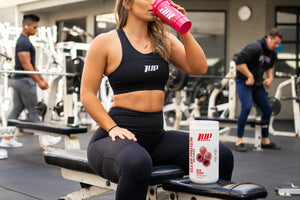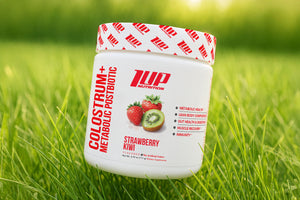Chances are if you’ve ever wanted to lose weight or entered a transformation challenge, you’ve wondered what you can do to “boost your metabolism”?
This is an incredibly common question.
But, what does it actually mean to “boost” your metabolism?
Is it getting saggy and need a lift?
Let’s discuss -- what does it mean to boost your metabolism?
We’ll start by explaining what your metabolism actually is.
What is Metabolism?
“Metabolism” is the process by which the body converts food or beverage into usable energy.
Metabolic rate is the speed at which your body uses energy (i.e. burns calories).
So, when individuals say they want to boost “metabolism”, what they really mean is that they want to either increase the speed at which their body burns calories (increasing calories burned per unit of time) or increase the total amount of calories they burn each day.
There are several components to your metabolism:
-
Basal metabolic rate (BMR): The number of calories your body requires to merely sustain life if all you did was lay still. This is the largest component of total daily energy expenditure (TDEE). It is affected by age, genetics, height, weight, and amount of muscle mass.
-
Thermic Effect of Feeding (TEF): The number of calories your body burns digesting and absorbing the foods you eat. It accounts for ~10% of TDEE.
-
Thermic Effect of Activity: The number of calories burned during structured physical activity (i.e. exercise).
- Non-exercise Activity Thermogenesis (NEAT): The number of calories burned doing non-exercise activities (folding laundry, washing dishes, tapping your toe, walking the dog, etc.). This component is highly variable from one individual to another depending on lifestyle and amount of fidgeting done daily.
Now, your metabolism is constantly churning and burning all day long.
But, there are a few things you can do to give your metabolic rate a short-term boost to increase the number of calories you burn during the day.
3 Ways to Boost Metabolism
#1 Resistance Training
The power of resistance training is finally starting to be realized by the average fitness enthusiast.
Not only does resistance training help build muscle & strength and improve body composition, it also increases resiliency, reduces injury risk, and improves bone density.
To top it off, resistance training can also help boost metabolism for up to several hours.[1]
The boosted metabolism is a by-product of excess post exercise oxygen consumption (EPOC).
EPOC (also known as the “afterburn effect”) refers to the additional oxygen and energy your body uses to restore homeostasis (repair damaged muscle, replenish glycogen and ATP stores, etc.) after an intense resistance training workout.
Research indicates that the “afterburn effect” may last anywhere from 12 hours post-workout to a few days, depending on the type of workout and the individual performing it.
Regardless of how big or how long this increased calorie burning lasts, every little bit helps and it will add up over time, especially if you’re consistently lifting weights three or four times a week.
#2 Interval Training
For decades, steady-state cardio was looked as the be all, end all modality of exercise to burn calories and lose weight.
That was until interval training exploded on the scene and showed that you could get the same calorie burn in a fraction of the time -- the only tradeoff was that you had to ramp up the intensity significantly.
Similar to resistance training, interval training workouts lead to the afterburn effect and can elevate your metabolic rate for up to 48 hours. Again, the magnitude of this increase will depend on the individual and the workout.[2,3]
Still, if you’re looking for a way to boost metabolism and not spend hours and hours slogging it out on the pavement or treadmill, interval training is the way to go.
#3 Sleep
The final way to boost your metabolism is something so simple, you probably don’t even think about it -- sleep.
Sleep is so vital to your ability to live a long, healthy, and happy life, it cannot be emphasized heavily enough.
When you don’t get enough sleep, your motivation to exercise (or really do anything) dwindles, which means you’re moving less during the day and burning less calories.
Sleep deprivation also makes you more lethargic, reducing non-exercise movement throughout the day, which again lowers your calorie burning.
Lack of sleep also impairs energy utilization and nutrient storage in the body, promoting more fat gain.
And, to top it off, not getting enough sleep also disrupts hunger and satiety hormones in the body, making it more likely you’ll overeat.
Therefore, if you want to keep your metabolism running optimally -- get enough sleep each night.
For the average adult, this is 7-9 hours per night of quality sleep.
References
- Osterberg KL, Melby CL. Effect of acute resistance exercise on postexercise oxygen consumption and resting metabolic rate in young women [published correction appears in Int J Sport Nutr Exerc Metab 2000 Sep;10(3):360]. Int J Sport Nutr Exerc Metab. 2000;10(1):71-81. doi:10.1123/ijsnem.10.1.71
- Børsheim E, Bahr R. Effect of exercise intensity, duration and mode on post-exercise oxygen consumption. Sports Med. 2003;33(14):1037-1060. doi:10.2165/00007256-200333140-00002
- LaForgia J, Withers RT, Gore CJ. Effects of exercise intensity and duration on the excess post-exercise oxygen consumption. J Sports Sci. 2006;24(12):1247-1264. doi:10.1080/02640410600552064






